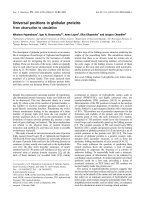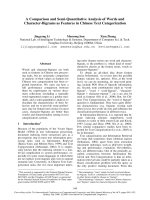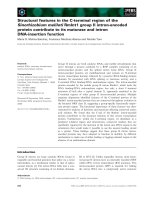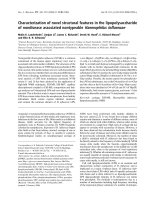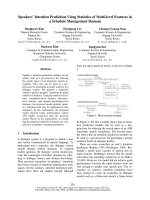Universal features in university
Bạn đang xem bản rút gọn của tài liệu. Xem và tải ngay bản đầy đủ của tài liệu tại đây (750.4 KB, 48 trang )
Universal features of
black holes
in the large D limit
Roberto Emparan
ICREA & U. Barcelona
w/ Kentaro Tanabe, Ryotaku Suzuki, Daniel Grumiller
Why black hole dynamics is hard
Non-decoupling:
BH is an extended object whose dynamics
mixes strongly with background
BH’s own dynamics not well-localized, not
decoupled
Why black hole dynamics is hard
BHs, like other extended objects, have
(quasi-) normal modes
but typically localized at some distance
from the horizon
∼ photon orbit in AF
in AdS backgrounds may be further away
→ hard to disentangle bh dynamics from
background dynamics
Why black hole dynamics is hard
BH dynamics lacks a generically small
parameter
Decoupling requires a small parameter
Near-extremality does it: AdS/CFT-type
decoupling
Develop a throat
effective radial potential
Large D limit
Kol et al
RE+Suzuki+Tanabe
1/D as small parameter
Separates bh’s own dynamics from background
spacetime
– sharp localization of bh dynamics
BH near-horizon well defined
– a very special 2𝐷 bh
Somewhat similar to decoupling limit in ads/cft
Large D limit
Far-region: background spacetime w/ holes
only knows bh size and shape
→ far-zone trivial dynamics
Near-region:
– non-trivial geometry
– large universality classes eg neutral bhs (rotating,
AdS etc)
Large D expansion may help for
– calculations: new perturbative
expansion
– deeper understanding of the theory
(reformulation?)
Universality (due to strong localization)
is good for both
Large D black holes
Basic solution
𝑟0
2
𝑑𝑠 = − 1 −
𝑟
𝐷−3
2
𝑑𝑟
2
𝑑𝑡 2 +
+
𝑟
𝑑Ω𝐷−2
𝐷−3
𝑟
1− 0
𝑟
length scale 𝑟0
Large D black holes
𝑟0 not the only scale
Small parameter 1 𝐷 ⟹ scale hierarchy
𝑟0 𝐷 ≪ 𝑟0
This is the main feature of large-D GR
Localization of interactions
Large potential gradient:
𝑟0
Φ 𝑟 ∼
𝑟
Φ 𝑟
𝐷−3
𝐷
𝛻Φ
𝑟0
∼ 𝐷/𝑟0
𝑟
𝑟0
⟹ Hierarchy of scales
𝑟0
𝐷
≪ 𝑟0
⟷
𝑟0
𝐷
Far zone
Fixed 𝑟 > 𝑟0
𝐷→∞
𝑟0
𝑓 𝑟 =1−
𝑟
𝐷−3
→1
𝑑𝑠 2 → −𝑑𝑡 2 + 𝑑𝑟 2 + 𝑟 2 𝑑Ω𝐷−2
Flat, empty space at 𝑟 > 𝑟0
no gravitational field
Far zone geometry
scale 𝒪 𝑟0 𝐷 0
Holes cut out in Minkowski space
scale 𝒪 𝑟0 𝐷 0
Far zone
Holes cut out in Minkowski space
No wave absorption (perfect reflection)
for 𝐷 → ∞
Near zone
Gravitational field appreciable only in thin
near-horizon region
𝑟0
𝑟
𝐷−3
𝑟0
= 𝒪 1 ⟺ 𝑟 − 𝑟0 <
𝐷
𝑟0
𝑟 − 𝑟0 ∼
𝐷
Near zone
Keep non-trivial gravitational field:
Length scales ∼ 𝑟0 /𝐷 away from horizon
Surface gravity 𝜅 ∼ 𝐷/𝑟0 finite
Near-horizon coordinate: 𝑅 = 𝑟 𝑟0
𝐷−3
All remain 𝒪(1) where grav field is non-trivial
Near zone
𝑟0
2
𝑑𝑠 = − 1 −
𝑟
𝑟
𝑟0
𝐷−3
2
𝑑𝑟
2
𝑑𝑡 2 +
+
𝑟
𝑑Ω𝐷−2
𝐷−3
𝑟0
1−
𝑟
𝐷−3
𝑡𝑛𝑒𝑎𝑟
= cosh2 𝜌
𝐷
=
𝑡
2𝑟0
finite
as 𝐷 → ∞
Near zone
2
𝑑𝑠𝑛ℎ
4𝑟02
2
→ 2 − tanh2 𝜌 𝑑𝑡𝑛𝑒𝑎𝑟
+ 𝑑𝜌2 + 𝑟02 𝑑Ω2𝐷−2
𝐷
2d string black hole
ℓ𝑠𝑡𝑟𝑖𝑛𝑔
𝑟0
∼ ,
𝐷
𝑟0
𝛼′ ~
𝐷
2
Elitzur et al
Mandal et al
Witten
Soda
Grumiller et al
Near zone universality: neutral bhs
2d string bh is near-horizon geometry
of all neutral non-extremal bhs
- rotation appears as a local boost
(in a third direction)
- cosmo const shifts 2d bh mass
More near-horizon structure than just
Rindler limit
Near zone universality
Charge modifies near-horizon geom
some are ‘stringy’ bhs
eg, 3d black string Horne+Horowitz
but many different solutions possess
same near-horizon
universality classes
Large D expansion:
1. BH quasinormal modes
2. Instability of rotating bhs
Massless scalar field
□Φ = 0
Φ=
𝐷−2
𝑟− 2
𝜙 𝑟 𝑒 −𝑖𝜔𝑡 𝑌ℓ (Ω)
𝑑2 𝜙
2
+
𝜔
− 𝑉 𝑟∗ 𝜙 = 0
2
𝑑𝑟∗
𝑟∗ : tortoise coord
𝑉(𝑟∗ )
horizon
𝑟0
infty
𝑟∗
Massless scalar field
2
𝐷
𝑉 𝑟∗ → 2 Θ(𝑟∗ − 𝑟0 )
4𝑟∗
𝐷→∞
𝐷
𝑉(𝑟∗ )
horizon
𝑟0
2
Truncated flat-space barrier
2𝑟0
infty
𝑟∗
Massless scalar field
𝐷2
𝑉 𝑟∗ → 2 Θ(𝑟∗ − 𝑟0 )
4𝑟∗
𝜔>
𝐷
𝐷
2𝑟0
: perfectly absorbed
2
2𝑟0
𝜔 = 𝒪(𝐷0 )/𝑟0 : perfectly reflected
horizon
𝑟0
infty
𝑟∗
Schwarzschild bh grav perturbations
Kodama+Ishibashi
Gravitational scalar, vector, tensor modes
𝑆𝑂(𝐷 − 1) reps
𝑉(𝑟∗ )
𝐷=7
ℓ=2
𝑟∗
Schwarzschild bh grav perturbations
scalar vector tensor
𝐷 = 500
ℓ = 500
Potential seen by
𝜔𝑟0 = 𝒪(𝐷)




